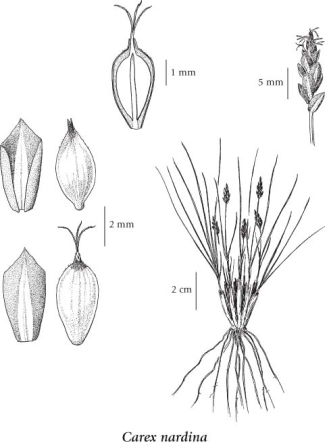Carex nardina Fr.
spikenard sedge (spike sedge)
Cyperaceae (Sedge family)
Introduction to Vascular Plants
spikenard sedge (spike sedge)
Cyperaceae (Sedge family)
Introduction to Vascular Plants
Species Information
General:
Perennial, densely tufted herb from fibrous roots; stems 2-15 cm tall, shorter than to slightly longer than the leaves.
Leaves:
Sheaths conspicuous, persistent, blunt at the mouths; blades 1 to 2 per stem, stiff, wire-like, persistent, borne on the lower 1/4 of the stem, about 0.5 mm wide.
Flowers:
Spikes solitary, cylindrical to egg-shaped, 5-15 mm long, erect, with both female and male flowers, the male flowers towards the tips; bractless.
Fruits:
Perigynia lanceolate to egg-shaped, 3.5-4.5 mm long, 1.2-2 mm wide, plano-convex, smooth, faintly nerved, finely toothed above, short-stalked, the beaks short, bidentate; female scales egg-shaped, about equalling the perigynia, sharp-pointed or rounded or the lowest ones awned, brownish, the midribs pale, the margins translucent; stigmas 2 or 3; achenes lens-shaped or 3-angled, about 2.5 mm long.
Illustration

If more than one illustration is available for a species (e.g., separate illustrations were provided for two subspecies) then links to the separate images will be provided below. Note that individual subspecies or varietal illustrations are not always available.
Illustration Source: The Illustrated Flora of British Columbia
Ecology
Ecological Framework for Carex nardina
The table below shows the species-specific information calculated from
original data (BEC database) provided by the BC Ministry of Forests and Range.
(Updated August, 2013)
The table below shows the species-specific information calculated from
original data (BEC database) provided by the BC Ministry of Forests and Range.
(Updated August, 2013)
| Site Information |
Value / Class |
||
|
Avg |
Min |
Max |
|
| Elevation
(metres) |
2093 | 39 | 2680 |
| Slope
Gradient (%) |
25 | 0 | 100 |
|
Aspect (degrees) |
220 | 0 | 360 |
| Soil
Moisture Regime (SMR) [0 - very xeric; 4 - mesic; 8 - hydric] |
2 | 0 | 7 |
| Modal
Nutrient Regime
Class |
B | ||
| #
of field plots species was recorded in: |
204 | ||
| Modal
BEC Zone Class |
AT | ||
|
All BEC Zones (# of stations/zone) species was recorded in |
AT(62), BAFA(33), BWBS(1), CMA(6), ESSF(55), IDF(2), IMA(32), MH(1), MS(2), SWB(5) | ||
|
Source:
Klinkenberg 2013
|
|||